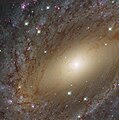Datei:The Milky Way’s big sister NGC 6744.jpg

Originaldatei (4.076 × 4.095 Pixel, Dateigröße: 10,71 MB, MIME-Typ: image/jpeg)
![]()
Diese Datei und die Informationen unter dem roten Trennstrich werden aus dem zentralen Medienarchiv Wikimedia Commons eingebunden.
Beschreibung
| BeschreibungThe Milky Way’s big sister NGC 6744.jpg |
English: This image taken by the NASA/ESA Hubble Space Telescope’s Wide Field Camera 3 (WFC3) shows a beautiful spiral galaxy called NGC 6744. At first glance, it resembles our Milky Way albeit larger, measuring more than 200 000 light-years across compared to 100 000 light-year diameter for our home galaxy.
NGC 6744 is similar to our home galaxy in more ways than one. Like the Milky Way, NGC 6744 has a prominent central region packed with old yellow stars. Moving away from the galactic core, one can see parts of the dusty spiral arms painted in shades of pink and blue; while the blue sites are full of young star clusters, the pink ones are regions of active star formation, indicating that the galaxy is still very lively. In 2005, a supernova, named 2005at, was discovered within NGC 6744, adding to the argument of this galaxy’s liveliness (not visible in this image). SN 2005at is a type Ic supernova, formed when a massive star collapses in itself and loses its hydrogen envelope. |
| Datum | |
| Quelle | https://spacetelescope.org/images/potw1830a/ |
| Urheber |
ESA/Hubble & NASA Acknowledgement: Judy Schmidt |
Lizenz
| ESA/Hubble images, videos and web texts are released by the ESA under the Creative Commons Attribution 4.0 International license and may on a non-exclusive basis be reproduced without fee provided they are clearly and visibly credited. Detailed conditions are below; see the ESA copyright statement for full information. For images created by NASA or on the hubblesite.org website, or for ESA/Hubble images on the esahubble.org site before 2009, use the {{PD-Hubble}} tag.
Conditions:
Notes:
|
- Dieses Werk darf von dir
- verbreitet werden – vervielfältigt, verbreitet und öffentlich zugänglich gemacht werden
- neu zusammengestellt werden – abgewandelt und bearbeitet werden
- Zu den folgenden Bedingungen:
- Namensnennung – Du musst angemessene Urheber- und Rechteangaben machen, einen Link zur Lizenz beifügen und angeben, ob Änderungen vorgenommen wurden. Diese Angaben dürfen in jeder angemessenen Art und Weise gemacht werden, allerdings nicht so, dass der Eindruck entsteht, der Lizenzgeber unterstütze gerade dich oder deine Nutzung besonders.
Kurzbeschreibungen
23. Juli 2018
image/jpeg
Dateiversionen
Klicke auf einen Zeitpunkt, um diese Version zu laden.
| Version vom | Vorschaubild | Maße | Benutzer | Kommentar | |
|---|---|---|---|---|---|
| aktuell | 13:33, 11. Jul. 2022 |  | 4.076 × 4.095 (10,71 MB) | Don-vip | full-res |
| 16:02, 24. Jul. 2018 |  | 3.981 × 4.000 (9,87 MB) | Jmencisom | User created page with UploadWizard |
Dateiverwendung
Die folgende Seite verwendet diese Datei:
Globale Dateiverwendung
Die nachfolgenden anderen Wikis verwenden diese Datei:
- Verwendung auf fr.wikipedia.org
Metadaten
Diese Datei enthält weitere Informationen (beispielsweise Exif-Metadaten), die in der Regel von der Digitalkamera oder dem verwendeten Scanner stammen. Durch nachträgliche Bearbeitung der Originaldatei können einige Details verändert worden sein.
| Namensnennung/Veröffentlicher | ESA/Hubble & NASA Acknowledgement: Judy Schmidt |
|---|---|
| Quelle | ESA/Hubble |
| Kurztitel |
|
| Bildtitel |
|
| Nutzungsbedingungen |
|
| Erfassungszeitpunkt | 06:00, 23. Jul. 2018 |
| JPEG-Dateikommentar | This image taken by the NASA/ESA Hubble Space Telescope’s Wide Field Camera 3 (WFC3) shows a beautiful spiral galaxy called NGC 6744. At first glance, it resembles our Milky Way albeit larger, measuring more than 200 000 light-years across compared to 100 000 light-year diameter for our home galaxy. NGC 6744 is similar to our home galaxy in more ways than one. Like the Milky Way, NGC 6744 has a prominent central region packed with old yellow stars. Moving away from the galactic core, one can see parts of the dusty spiral arms painted in shades of pink and blue; while the blue sites are full of young star clusters, the pink ones are regions of active star formation, indicating that the galaxy is still very lively. In 2005, a supernova, named 2005at, was discovered within NGC 6744, adding to the argument of this galaxy’s liveliness (not visible in this image). SN 2005at is a type Ic supernova, formed when a massive star collapses in itself and loses its hydrogen envelope. |
| Stichwörter | NGC 6744 |
| Kontaktinformationen |
Karl-Schwarzschild-Strasse 2 Garching bei München, , D-85748 Germany |
| IIM-Version | 4 |

